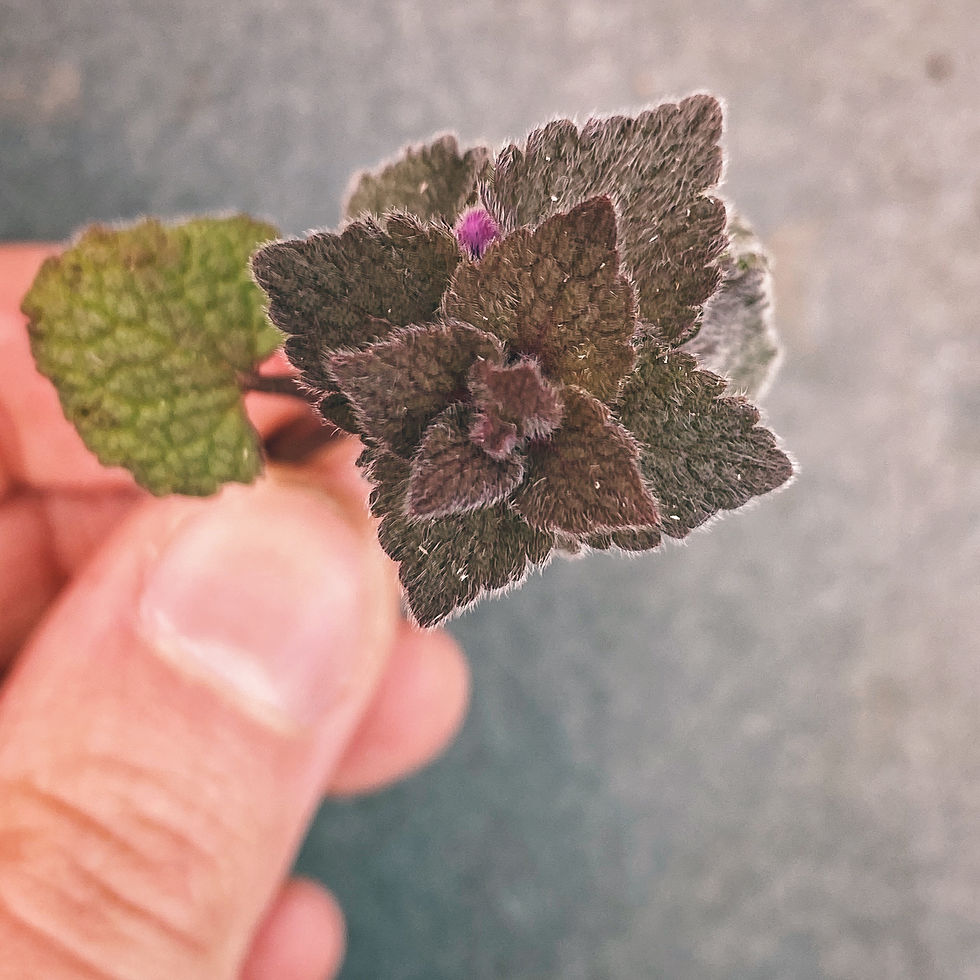Differential Morphology of Purple Deadnettle, Henbit, & Ground Ivy
- Calyx

- Apr 25, 2020
- 2 min read
Updated: May 2, 2021

These three common mints are abundant in yards, gardens, fallow fields, and disturbed soil all across the US. All being of similar size and overall shape, with almost identical little purple irregular flowers, they are often confused with each other.
To help you get to know their unique features, I've created a video to show you some simple characteristics to look for to tell them apart and laid out the details in this post. You can check out the video on our facebook page: https://www.facebook.com/107342484222450/videos/223410732284967/
Morphological Characteristics of the Mint family (Lamiaceae)
Square stem
Opposite leaves
Usually Aromatic
Almost always zygomorphic flowers irregular flowers with 5 petals (3 up, 2 down)
1. Lamium purpureum -Purple Deadnettle (Red Deadnettle, Red Henbit)

Purpureum refers to the purple pigmentation of the top leaves and flowers, which come from anthocyanin flavonoids
Morphology:
Leaves are deltoid or cordate
Serrate margins
Opposite leaves with petioled (or stalked) leaf attachment
Leaves turn reddish/purple toward the top of the stem
Edible & Medicinal:
Cooling, astringent, diaphoretic - good for hot conditions & inflammation (rheumatism, fevers, etc.)
Antibacterial & Antifungal
Vulnerary
Highly nutritious - packed with Vitamin C & flavonoids, antioxidants, iron
Mild tasting but a little fuzzy- great pot herb
2. Lamium amplexicaule - Common Henbit (Greater Henbit, Henbit Deadnettle)

Morphology:
Reniform leaves
Crenate to shallowly lobed margins
Opposite leaves that have no petiole (sessile) clasp the stem (amplexicaul)- have the appearance of being whorled but but are actually opposite
Flowers, however, are in whorls at the top of the stem
Edible & Medicinal
Cooling, astringent, diaphoretic - good for hot conditions & inflammation
Vulnerary
High in iron, vitamins, antioxidants
Tastes like raw kale - great raw or as pot herb
3. Glechoma hederacea syn. Nepeta hederacea - Ground Ivy (Gill-over-the-ground,

Creeping Charlie, Robin Runaway, Alehoof, Field Balm, Catsfoot)
Hederacea = “of ivy”
Morphology:
Reniform to orbicular leaves
Crenate margins
Long petioles
Slightly bitter
Edible & Medicinal
Bitter, hepatic herb - helps the body detoxify - has been used for heavy metal poisoning
Use for inflamed mucous membranes
Antiseptic
High in vitamin C
Great pot herb, a bit bitter for salads
Differential Characteristics:
Flowers are all very similar; irregular & purple in color, all have square stems, opposite leaves, all have pubescent leaves, all grow under 2’ in height
L. purpureum: Have petioles, cordate-deltoid, serrate leaves
L. amplexicaule: No petioles (amplexicaul), reniform, crenate leaves
G. hederacea: Long petioles, reniform-orbicular, crenate leaves




Loved how you broke down the differences between these plants super informative! I’ve got ground ivy growing in a small pot, and it’s fascinating to notice how its structure differs from other ivies. An ivy plant pot truly makes observing these details easier!
chicadepeace, In general plants do not uptake enough lead from the soil to be dangerous, but it does depend on how high the soil content is and it can vary from plant to plant. In plants that do bioaccumulate lead, it tends to be concentrated in the roots because lead does not transport quickly through the tissues of the plants, so the arial parts generally have lower concentrations. Unfortunately I don't have any specific information about these three plants, but I do know that G. hederacea has historically been used for "painter's colic," which is lead poisoning from lead paint. There have been some studies done around how lead may bioaccumulate in Ground Ivy as it pulls it from the…
Thank you for the very informative breakdown and close up shot in this video. I have all three in my yard and am excited to try them! Harpers Ferry, WV
Such a wealth of knowledge! I think I may have all of these in my backyard. I'd love to eat them. But the soil in my yard tested high for lead. Is lead bioavailable in them? Do you know where I could find out that information?